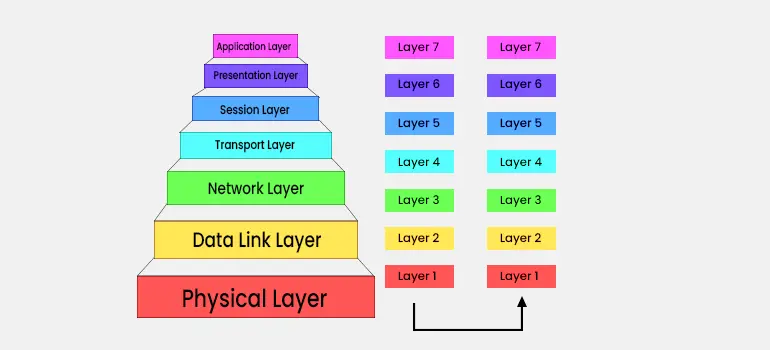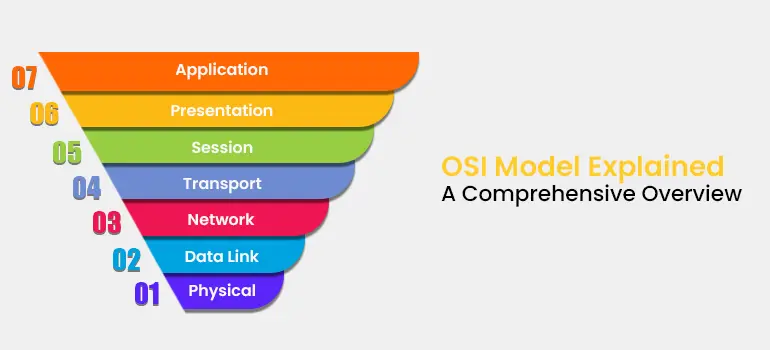The OSI (Open Systems Interconnection) model serves as a vital framework for understanding the intricacies of telecommunication and computing systems. Comprising seven distinct layers, each with specific responsibilities, this model simplifies network operations by breaking down the communication process into manageable components.
Throughout this blog post, we'll explore the OSI model in depth, analyzing the significance of each layer in facilitating seamless communication between devices.
OSI Model Layers: Functions and Responsibilities
The OSI model is a framework for networking that consists of seven layers, each with unique functions and responsibilities. Understanding the role of each layer is essential for comprehending the flow of data within a networked environment.
The OSI model consists of seven layers that serve as a framework for understanding network communication. The layers are as follows:
- Physical Layer: This layer is responsible for transmitting and receiving raw data bits over a physical medium.
- Data Link Layer: Its primary function is to ensure reliable point-to-point and point-to-multipoint communication by detecting and correcting errors.
- Network Layer: This layer manages network addressing, routing, and packet forwarding to facilitate data transfer between devices.
- Transport Layer: It provides end-to-end communication services, including error detection, flow control, and data segmentation.
- Session Layer: The session layer establishes, maintains, and terminates communication sessions between applications on different devices.
- Presentation Layer: This layer handles data translation, encryption, and compression to ensure compatibility between different systems.
- Application Layer: The application layer facilitates user interaction with network services and applications, such as web browsers and email clients.
In the following sections, we will explore the functions and interactions of each OSI layer, uncovering the intricacies of network communication.
Anatomy of the OSI Model: Understanding Each Layer
In the Open Systems Interconnection (OSI) model, each layer has a specific responsibility in facilitating communication between network devices. Let's explore the functions of each layer:

Physical Layer
- Responsible for physical transmission of data across network medium.
- Includes necessary hardware components and signaling mechanisms.
- Ensures reliable sending and receiving of bits.
- Focuses on voltage levels, data rates, transmission modes.
Major Functions of the Physical Layer:
- Physical Topologies:
- Describes arrangement of nodes or devices in a network.
- Bitrate Control:
- Defines number of bits sent per second or rate of transmission.
- Transmission Mode:
- Determines how data flows between devices.
- Includes simple, full-duplex, and half-duplex modes.
- Bit Synchronization:
- Provides clock to synchronize bits between sender and receiver.
- Ensures synchronization at bit level in communication process.
Data Link Layer
The Data Link Layer sits on top of the Physical Layer and is responsible for ensuring smooth transmission of data frames between adjacent network nodes. This layer is further divided into two sublayers: the Media Access Control (MAC) sublayer, which manages addressing and channel access, and the Logical Link Control (LLC) sublayer, which is responsible for flow control and error handling.
Key Functions of the Data Link Layer:
- Framing: By adding distinctive patterns at frame boundaries, the layer enables the meaningful transmission of bit sets.
- Physical Addressing: Each frame header includes the physical addresses of both sender and receiver.
- Access Control: In shared communication channels, the MAC sublayer determines device control.
- Flow Control: Ensures consistent data transmission rates to prevent data corruption.
- Error Control: Detects and rectifies damaged or lost bits, maintaining data integrity.
In essence, the Data Link Layer serves as a cornerstone for reliable and efficient communication among network devices, adeptly managing framing, addressing, access, flow, and error correction.
Network Layer
- The Network Layer is crucial for establishing efficient and reliable communication among networked devices.
- Positioned above the Data Link Layer, responsible for routing and forwarding data packets across various networks.
- Assigns logical addresses (IP addresses) to devices and determines optimal transmission paths based on network topology and congestion levels.
- Relies on routing protocols like IP and routing algorithms for efficient packet delivery.
Key Functions of the Network Layer:
- Routing and Forwarding:
- Determines best paths for data transmission between networks.
- Logical Addressing:
- Assigns IP addresses to devices for identification.
- Packet Encapsulation:
- Segments data into packets and adds routing information for transmission.
- End-to-End Communication:
- Facilitates communication between devices on different networks.
Transport Layer
- Acts as mediator between upper-layer applications and lower-level network services.
- Ensures reliable data transfer from source to destination.
- Establishes connections, manages data segmentation and reassembly, and provides error detection and correction mechanisms.
Primary Protocols Supported:
- TCP (Transmission Control Protocol):
- Connection-oriented communication with guaranteed delivery.
- UDP (User Datagram Protocol):
- Connectionless, best-effort delivery.
Mechanisms for Optimal Data Transfer:
- Flow Control: Regulates data flow to prevent overwhelming receiver.
- Congestion Avoidance: Manages data flow to prevent network congestion.
Transport Layer Services:
- Connection-less Services:
- Involves single phase: data transfer without acknowledgment.
- Faster communication between devices.
- Connection-oriented Services:
- Involves three phases: connection establishment, data transfer, disconnection/termination.
Session Layer
- Located above the Transport Layer, responsible for establishing, managing, and terminating communication sessions between applications.
- Allows multiple processes on different devices to establish connections, exchange data, and synchronize activities.
- Manages session control to organize data into logical units for transmission.
Key Features:
- Facilitates Dialogues (Conversations):
- Provides rules for starting, maintaining, and ending dialogues between applications.
- Synchronization and Ordering:
- Ensures data exchanged between devices is synchronized and ordered throughout communication session.
- Checkpointing Mechanisms:
- Supports recovery from communication failures by establishing checkpoints for session resumption.
- Session Multiplexing:
- Enables concurrent operation of multiple sessions over a single network connection, enhancing efficiency and resource utilization.
Presentation Layer
- Positioned above the Session Layer in the OSI model hierarchy.
- Acts as a bridge between the Application Layer and the Session Layer.
- Ensures seamless data exchange between applications by handling data translation, encryption, and compression.
- Converts data into a standardized format for transmission over the network, ensuring interoperability.
- Handles data formatting and syntax conversion, converting between different data formats and character sets.
Key Functions:
- Data Encryption and Decryption:
- Converts data into coded form using a key value for confidentiality.
- Data Compression:
- Reduces data size for efficient transmission over the network.
- Data Translation:
- Translates incoming data into semantics understandable by receiving device.
- Handles interoperability between different data encoding methods.
Translation Layer:
- Located above the Session Layer and below the Application Layer in the OSI model.
- Converts sender-dependent format into common format and vice versa.
- Facilitates interoperability between different methods of encoding data.
Application Layer
- Positioned at the top of the OSI model hierarchy, serving as the interface between user applications and the network.
- Facilitates various network services such as email, file transfer, remote access, and distributed databases.
- Supports a wide range of application-specific protocols to enable seamless communication between applications and the network.
- Manages user authentication, authorization, and encryption to ensure secure data transmission.
- Provides an intuitive interface for users to interact with network resources and services.
Functions of the Application Layer:
- Mail Services:
- Stores and forwards emails, facilitating email communication.
- Directory Services:
- Distributes database sources, aiding in data management and retrieval.
- File Transfer Access and Management (FTAM):
- Facilitates file transfer and management operations over the network.
OSI Model in Action: Understanding Data Transmission

- Framework for Communication:
- OSI (Open Systems Interconnection) model outlines the data transmission process over networks.
- Layered Structure:
- Consists of seven layers, each assigned specific tasks for successful data transfer.
- Physical Layer:
- Converts data into electrical signals, radio waves, or light pulses for transmission across the network medium.
- Data Link Layer:
- Places data into frames and implements error detection and correction mechanisms for reliable transmission.
- Network Layer:
- Routes data packets through intermediate network devices like routers to reach their destination.
- Transport Layer:
- Establishes connections and ensures reliable data delivery through segmentation, acknowledgment, and retransmission.
- Session Layer:
- Coordinates communication sessions between applications, allowing for connection establishment, maintenance, and termination.
- Presentation Layer:
- Handles data formatting, encryption, and compression to ensure compatibility between different systems.
- Application Layer:
- Provides network services directly to end-user applications, enabling user interaction with network resources.
- Structured Approach:
- OSI model divides data transmission process into manageable layers, each with specific functions and responsibilities.
Benefits of OSI Model in Networking
The OSI model is a framework for networking that provides several benefits:
- It organizes the complex process of data transmission into seven layers, allowing for efficient problem-solving.
- It promotes interoperability and standardization in networking protocols and technologies.
- It offers scalability and flexibility in network architecture, allowing for the introduction of new technologies and protocols without disrupting the entire system.
- It serves as a common language for communication among network professionals, fostering collaboration and knowledge sharing.
- By leveraging these advantages, organizations can build robust and reliable network infrastructures that meet the demands of today's interconnected world.
Conclusion
The OSI model is a standardized framework with seven layers that helps engineers design, troubleshoot, and optimize networks. It is a universal language for networking and remains an essential tool for success in the technology landscape.


